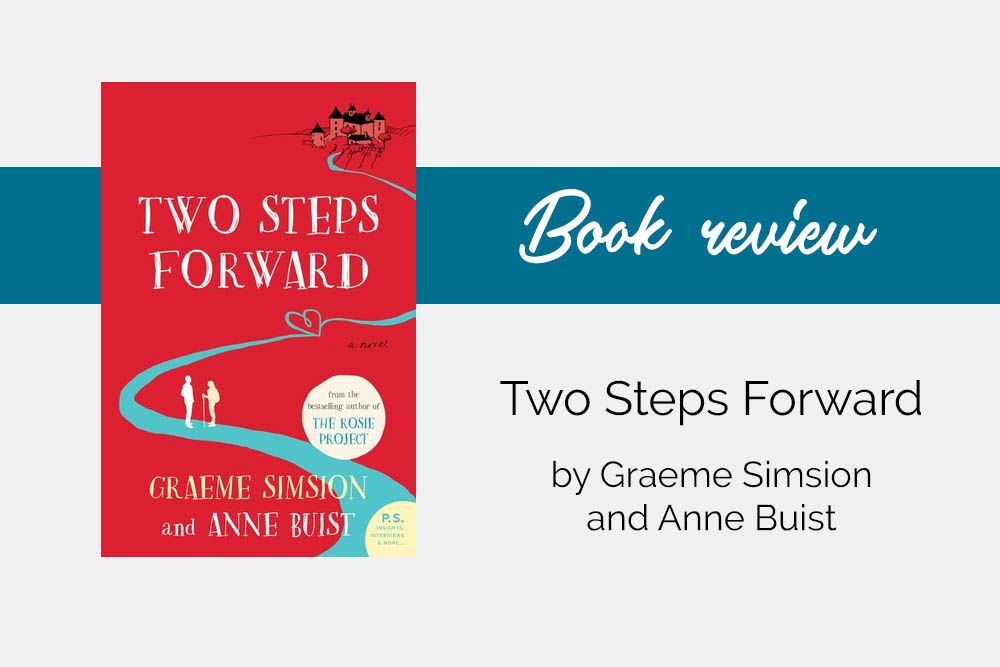A Camino novel: Two Steps Forward
Two Steps Forward
By Graeme Simsion and Anne Buist
Buy from Amazon (affiliate link)
Published May 1, 2018 (paperback) by William Morrow Paperbacks
I was excited to read a novel set on the Camino de Santiago, because my husband and I are planning our own Camino hike for next year. I had previously looked for books about Camino experiences (not guide books) and didn’t come up with anything that looked too promising. I did listen to Shirley MacClaine’s memoir, The Camino: A Journey of the Spirit, which is less about the actual Camino and more about her spiritual journey along the way, and a lot of it was pretty bonkers.
For those not familiar with the Camino, it’s a pilgrimage across northern Spain that leads to the shrine of the apostle Saint James in the cathedral of Santiago de Compostela in Galicia. While it’s traditionally a spiritual pilgrimage, it’s become popular with hiking enthusiasts, evidently due to the 2010 Martin Sheen movie The Way.
There are different routes to the Camino, the most popular being the Camino Francés, which starts in Saint-Jean-Pied-de-Port, on the French side of the Pyrenees, and traverses northern Spain for a distance of about 500 miles.
Two Steps Forward was written by a husband and wife team who, as I understand it, have hiked the Camino twice: once on the Camino Francés and once on the northern route, the Camino del Norte. The book is about two main characters, Zoe and Martin, who find themselves hiking the Camino for different reasons. Zoe is a recently widowed American and Martin is a British engineer who is testing out a cart he’s invented to help pilgrims — as they’re known — carry their belongings along the journey.
Unfortunately, there was a lot about this book that didn’t work for me. The pacing was really uneven. The early chapters rely heavily on Camino logistics: where the characters stayed, how much it cost, how far they walked each day, etc. I was marginally interested in this information because of the insights it provided into the Camino experience, but I’m not sure it would interest someone who wasn’t planning their own Camino hike. But it wasn’t exactly useful information, as Martin and Zoe are not taking the traditional route: they both start in Cluny, France, and it’s a while before they even arrive at Saint-Jean-Pied-de-Port. Initially, Zoe doesn’t plan on continuing into Spain because of her limited funds.
As many Goodreads reviewers have pointed out, it’s a slow start. I was probably a good 40% into the book before I felt like I started getting to know the characters enough to even care why they were making this journey. And a lot of the information was delivered in summary, which didn’t help.
I felt like there was a lot to work with here that didn’t quite materialize, and I wanted more character development, especially in the beginning. Zoe’s husband died 3 weeks prior and she doesn’t seem to be grieving much at all, so I wasn’t really sure how she felt toward her husband. Martin’s personal journey turns out to be more about his relationship with his daughter, but that doesn’t really become evident until well into the story either.
More than once in the book, some events are skipped over and then recounted later, which seemed like an odd narrative choice to me. Maybe the authors thought it would add more tension, but it just made me feel like I had missed something. These events would have had more impact if we had seen them play out in real time.
Much of the book is driven by a miscommunication trope. The characters are constantly misunderstanding each other or misinterpreting something. The first few times this happens, it’s kind of cute. But it never stops. After a while, I felt like oh my god why don’t you just communicate with each other?? And I didn’t even feel that much chemistry between them.
The pacing gets better in the end, because there’s actually a crisis that needs to be solved. But getting there was a bit of a slog.
Related reading
The Camino: A Journey of the Spirit, by Shirley MacClaine
Tags In
Karen Eisenbraun
Related Posts
1 Comment
Leave a Reply Cancel reply
Categories
- Books (13)
- Nutrition (1)
- Personal growth (9)
- Spirituality (2)
- Writing (2)









[…] started this a while ago but it wasn’t really holding my attention, and I set it aside to read something a little lighter while I was on vacation. I haven’t officially marked it as DNF yet, but now that I’m well into […]